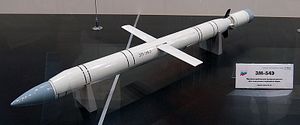Vietnam is in the process of acquiring 50 anti-ship and land attack 3M-14E Klub supersonic cruise missiles for its burgeoning fleet of SSK Kilo-class diesel-electric submarines, Der Spiegel Online reports.
According to the article, the Stockholm International Peace Research Institute (SIPRI) recently updated data on its website, based on information obtained from the United Nations’ register of conventional arms, indicating that Russia has already delivered 28 missiles over the last two years to Hanoi, although the precise number remains unknown.
The Klub is a Russian-made conventional supersonic cruise missile, “designed to destroy targets protected by sophisticated active air defenses and countermeasures,” deagel.com explains. It is an export variant of Russia’s “carrier killer” 3M-54 (NATO designation: SS-N-27A “Sizzler”) and capable of long-range precision strikes.
While it is unknown whether the anti-ship variant of the weapon sold to Vietnam is the 3M-54E Klub-S (range 220km) or 3M-54E1 (range 300km) – both of which can be launched from submarines – the land-attack variant is almost certainly the 3M-14E (range 300km), capable of carrying a 450kg warhead.
The purchase of land attack cruise missiles mark a “massive shift” beyond advancing the Vietnamese’s Navy’s anti-ship capabilities, according to naval analyst Carl Thayer quoted by Reuters. “They’ve given themselves a much more powerful deterrent that complicates China’s strategic calculations,” he added.
Principal targets for the new missile could be the Chinese naval base at Sanya on China’s Hainan Island and military facilities (e.g., ports and airfields) that China is building in the potentially oil-rich South China Sea (see: “South China Sea: China’s Unprecedented Spratlys Building Program”).
The launch platforms for Vietnam’s new weapons will be six 4,000-ton Type 636 Kilo-class diesel-electric submarines – labelled “black holes” by the U.S. Navy due to their quietness, according to UNSI News.
The website naval-technology.com notes about the Type 636 Kilo-class:
Type 636 is designed for anti-submarine warfare (ASW) and anti-surface-ship warfare (ASuW) and also for general reconnaissance and patrol missions. The Type 636 submarine is considered to be to be one of the quietest diesel submarines in the world. It is said to be capable of detecting an enemy submarine at a range three to four times greater than it can be detected itself.
The Vietnamese Navy has already commissioned two Kilo-class vessels – the HQ-182 Hanoi and HQ-183 Ho Chi Minh City – in 2014, while it received the third sub, the HQ-184 Haiphong, in February of this year.
Reuters states that the fourth Kilo-class vessel is already in transit to Vietnam, with a fifth undergoing seal-trials in St. Petersburg and the sixth and last to be completed and delivered in 2016. Hanoi and Moscow signed a $ 2.6 billion contract for the modernization of Vietnam’s submarine fleet back in 2009.
Once the last vessel is commissioned, Vietnam will have the most modern submarine force in all of Southeast Asia. Its principal purpose will be to act as a credible deterrent force to Chinese “adventurism” in Vietnam’s maritime domain.
However, as Carl Thayer noted in The Diplomat (see: “Can Vietnam’s Maritime Strategy Counter China?”) it remains to be seen whether Vietnam can develop new doctrines and tactics to use its new weapon platforms, and how quickly the Vietnamese Navy can integrate its new fleet of submarines into the country’s overall counter-intervention strategy vis-à-vis Beijing.
“The views of defense analysts range from skeptical to cautiously optimistic about Vietnam’s ability to develop an effective counter-intervention strategy to deter China in Vietnam’s maritime domain,” Thayer summarizes.
He concludes:
The purpose of Vietnam’s counter-intervention strategy is intended to deter China from deploying PLAN warships at the lower end of the conflict spectrum, such as assisting civilian law enforcement agency vessels operating in Vietnamese waters or blockading Vietnamese-held islands and features in the South China Sea.
































